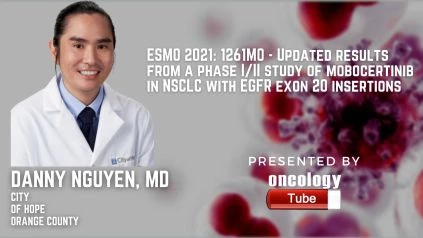Danny Nguyen, MD, Assistant Clinical Professor, Department of Medical Oncology & Therapeutics Research, City of Hope Orange County Irvine speaks about ESMO 2021 Abstract – 1261MO – Updated results from a phase I/II study of mobocertinib (TAK-788) in NSCLC with EGFR exon 20 insertions (exon20ins).
Link to Abstract:
https://cslide.ctimeetingtech.com/esmo2021/attendee/confcal_4/presentation/list?q=1218P+&r=pt%7E53
Summary –
Backstory:
According to the independent review committee (IRC), the phase I/II study (NCT02716116) of mobocertinib 160 mg QD in platinum-pretreated patients (PPP) with EGFRex20ins+ NSCLC showed a verified objective response rate (ORR) of 28 percent; GI toxicities were the most common side events (AEs).
Methodologies:
We provide ORR, DoR, and PFS per IRC in patients with and without adverse events (AEs) that resulted in dosage reductions, the majority of which were related to GI toxicity. We describe all-grade (gr) and gr 3/4 diarrhea, vomiting, and nausea; perform an exposure-safety analysis to further characterize diarrhea; and investigate the connection between diarrhea and several factors, including age.
Outcomes:
Pts with AEs resulting in dose reductions had an ORR of 21% (95 percent CI: 8.0, 39.7), while those without had an ORR of 31% (21.1, 41.5); DoR was 5.7 mo (3.7, not achieved [NR]) and 17.5 mo (7.4, NR); PFS was 5.9 mo (3.7, 11.0) and 7.3 mo (5.5, 10.8), respectively. 21/29 patients with AEs that resulted in dose reductions had their dose reduced due to GI toxicity. In the PPP, 96 percent of patients experienced at least one GI toxicity: all-gr and gr 3/4 diarrhea (93 percent and 22 percent, respectively); nausea (40 percent and 4 percent); and vomiting (41 percent and 3 percent, respectively). In 62 percent of patients with all-gr diarrhea, symptoms appeared within the first seven days, were largely mild at the time of onset, had a median time to resolution of 0.29 weeks, and were treated with antidiarrheal medicine in 74 percent of cases (Table). Mobocertinib plasma exposure (40-mg dose increase; hazard ratio [HR] 1.11 [95 percent CI: 1.04, 1.19]) and age (75 vs 75 y; HR 2.13 [95 percent CI: 1.38, 3.30]) were both statistically significant predictors of grade 2 diarrhea.
Findings:
Dose reductions, which were mostly due to GI toxicity, had an impact on efficacy outcomes. The majority of the gastrointestinal effects were mild. The most common GI hazard was diarrhea, which occurred most frequently in the first week and was influenced by mobocertinib exposure and age 75 years.
Clinical trial identification:
NCT02716116

